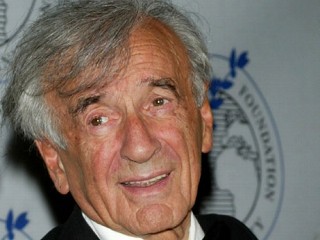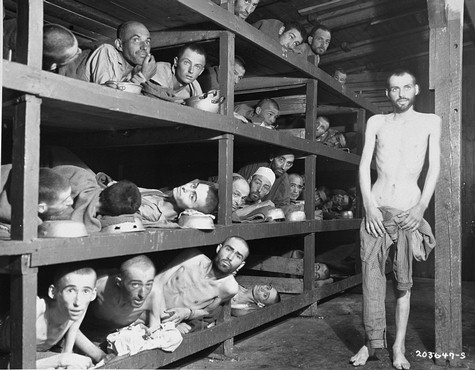
Latest! "Elie Wiesel" and his Accuser are in Famous Buchenwald
Photo (See below main story)
English Language Exclusive!
Translated from the Hungarian
by our Budapest Bureau
This article was
based on this one
Miklos Gruner personally approached the journal a few days ago to
propose a free interview. Gruner was accompanied by an Hungarian
doctor of medicine.
-----------------------------------
In May 1944 , when Miklos Gruner was 15, he was deported from
Hungary to
Auschwitz-Birkenau
with his mother and father as well as
both a younger and an elder brother. He says that his mother and his
younger brother were immediately gased after their arrival in the
camp. Then he, his elder brother and their father had an
inmate number tattooed on their arms and were sent to perform hard
work in a synthetic fuel factory linked to IG Farben where the
father died six months later. After that, the elder brother was sent
to Mauthausen and, as the young Miklos was then alone, two elder
Jewish inmates who were also Hungarians and friends with his late
father took him under their protection. These two protectors of
the young Miklos were the Lazar and Abraham Wiesel brothers.
In the following months, Miklos Gruner and the Wiesel brothers
became good friends. Lazar Wiesel was 31 years old in 1944.
Miklos never forgot the number Lazar was tattooed with by the
Nazis: A-7713. In January 1945, as the Russian army was coming,
the inmates were transferred to Buchenwald. During the ten days
this transfer took, partly by foot, partly by train, more than
half of the inmates died and amongst them was Abraham, the elder
brother of Lazar Wiesel. In April 8, 1945, the US army liberated
Buchenwald. Miklos and Lazar were amongst the survivors of the
camp. As Miklos had tuberculosis, he was sent in a Swiss clinic
and therefore was separated from Lazar. After recovering, Miklos
emigrated to Australia while his elder brother, who also
survived the war, established himself in Sweden.
Years later, in 1986, Miklos was contacted by the Swedish
journal Sydsvenska Dagbladet in Malmo and invited to meet "an
old friend" named Elie Wiesel... As Miklos answered that he doesn`t
know anyone with this name, he was told Elie Wiesel was the same
person Miklos knew in the Nazi camps under the name Lazar Wiesel
and with the inmate number A-7713... Miklos still remembered
that number and he was therefore convinced at that point that he
was going to meet his old friend Lazar and happily accepted the
invitation to meet him at the Savoj Hotel in Stockholm on
December 14, 1986. Miklos recalls:
" I was very happy at the idea of meeting Lazar but when I
confronted the so-caled "Eli Wiesel", I was stunned to see a man
I didn`t recognize at all, who didn`t even speak Hungarian or
Yiddish and instead he was speaking English in a strong
French accent. Therefore our meeting was over in about ten
minutes. As a goodbye gift, the man gave me his book entitled
"Night" of which he claimed to be the author. I accepted the
book I didn`t know at that time but told everyone there that
this man was not the person he pretended to be!"
Miklos recalls that during this strange meeting, Elie Wiesel
refused to show him the tattooed number on his arm, saying he
didn`t want to exhibit his body. Miklos adds that Elie Wiesel
showed his tattooed number afterward to an Israeli journalist
who Miklos met and this journalist told Miklos that he didn`t
have time to identify the number but... was certain it wasn`t a
tattoo. Miklos says:
- After that meeting with Elie Wiesel, I spent twenty years of
research and found out that the man calling himself Elie Wiesel
has never been in a Nazi concentration camp since he was not
included in any official list of detainees.
Miklos also found out that the book Elie Wiesel gave him in 1986
as something he has written himself was in fact written in
Hungarian in 1955 by Miklos' old friend Lazar Wiesel and
published in Paris under the title "Un di Velt hot Gesvigen",
meaning approximately "The World Kept Silent". The book was
then shortened and rewritten in French as well as in English in
order to be published under the author`s name Elie Wiesel in
1958, under the french title "La Nuit" and the English title
"Night". Ten million copies of the book were sold in the world
by Elie Wiesel who even received a Nobel Peace prize for it in
1986 while -says Miklos- the real author Lazar Wiesel was
mysteriously missing...
- Elie Wiesel never wanted to meet me again, says Miklos. He
became very successful; he takes 25 thousand dollars for a 45
minutes speech on the Holocaust. I have officially reported to
the FBI in Los Angeles.I have also complained to governments and
media, in the US and Sweden with no result.
I have received anonymous calls telling me I could be shot if I
don`t shut up but I am not afraid of death any more. I have
deposited the whole dossier in four different countries and, if
I died suddenly, they would be made public. The world must know
that Elie Wiesel is an impostor and I am going to tell it, I am
going to publish the truth in a book called "Stolen Identity
A7713".
----------
PERSON IDENTIFIED AS ELIE WIESEL IN FAMOUS BUCHENWALD PHOTO IS
NOT WIESEL
Miklos Gruner and "Elie Wiesel" are in the
most famous Holocaust Picture, taken at Buchenwald on April
16, 1945. Gruner is the boy at the extreme left on the bottom
row, while "Wiesel" is 7th from left, middle row. "Wiesel"
looks pretty old to be born in 1928, i.e 17 years old. Compare
with Miklos Gruner who was 16. According to Gruner this man is
not Lazar Wiesel or Elie Wiesel. He implies neither Lazar Wiesel
nor Elie Wiesel are this picture.
"Itt voltunk 1945. április 8-ig, itt szabadítottak fel
minket a bevonuló amerikai csapatok. Én rajta is vagyok
azon a fényképen, amelyet a táborról készítettek és
bejárta a világot."
Translation: "We (himself and Lazar) were there
(Buchenwald) until April 8, 1945 when we were
liberated by the Americans. I myself am even in that
camp photo which was taken then by the Americans and
was shown all over the world."
My correspondent writes: "the identification number given for "Elie
Wiesel" on the picture (123565) isn`t even the number Gruner
says was tattooed on Lazar Wiesel."
Look at the man in the photo presented as Elie Wiesel: he is
not a teenager but a man in his late 20's or 30's.
Hit the "Mehr Informationen" botton (+) bottom left for id
of prisoners.



I am a Hungarian and I can tell you that Mr. Wiesel doesn't have a Hungarian accent.
Miklos Gruner also noticed that. He speaks English with some other accent. My guess is that he has some kind of Slavic accent. But this is only a guess. People can fake identities but cannot fake handwriting or accent. Here is an idea. Would be interesting to ask the opinion of an accent expert or an accent coach. Show them a sample of Mr Wiesel's speech and say Mr. Soros'; two video clips from you-tube to compare. Both have Hungarian backgrounds. It can be very easily established that Mr. Soros has a Hungarian accent, but what kinds of accent Mr Wiesel has? Finding out this would clarify where he is coming from.Hungarian accent can be easy to picked out if you watch out for the pronunciation of vowels like i, e, a, u. Hungarian vowels are rounded unlike English vowels, which are un-rounded. Hungarians pronounce English words with rounded vowels, this is where the typical accent is coming from.